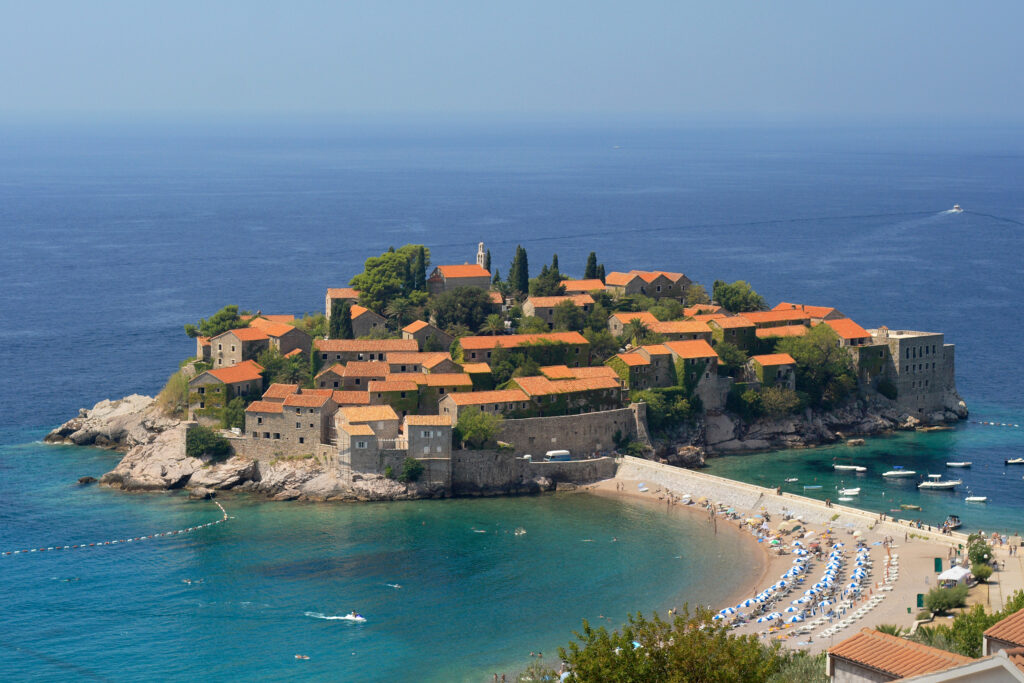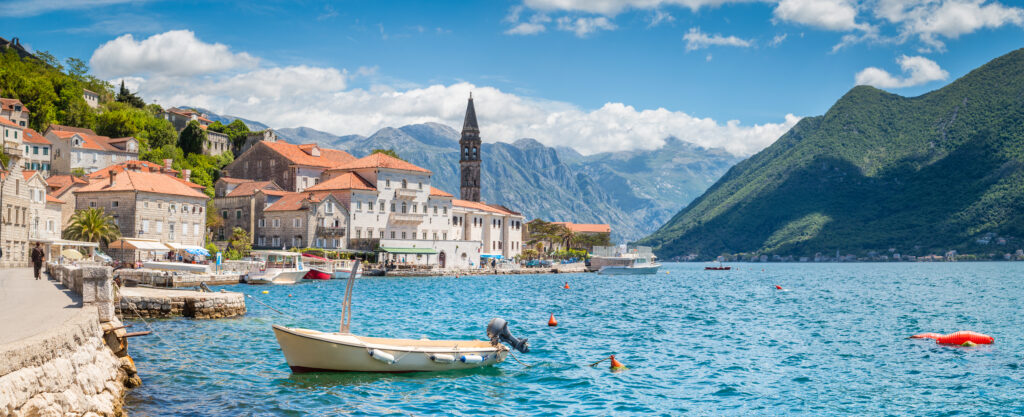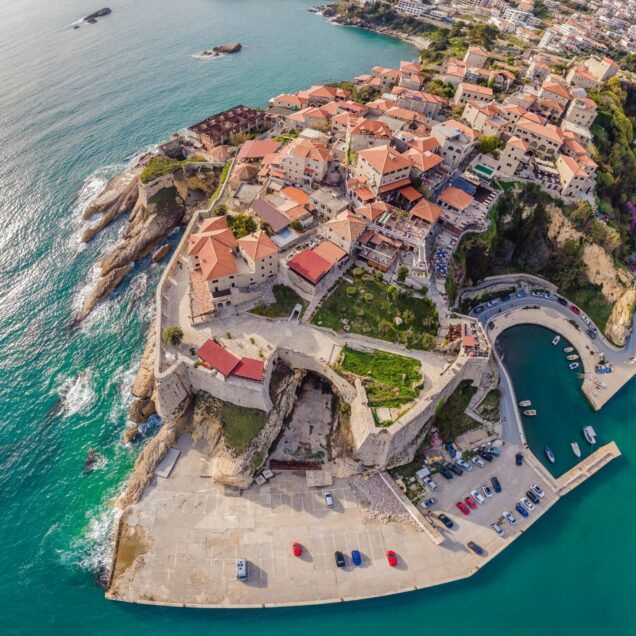

Montenegro, meaning Black Mountain, is a tiny Balkan republic and one of the world’s newest independent nations. The fabulously jagged coastline along the Adriatic Sea offers a variety of beaches, coves, bays and islets that make for interesting summer walks. During a Montenegro adventure tour you can explore Kotor, a museum town of ancient seafarers, builders and scientists, was built at the bottom of Europe’s deepest fjord in the shadow of dramatic karstic mountains between the 12th and 14th century.


For centuries, Kotor has been a crossroads of commercial routes under the influence of Venice. The UNESCO World Heritage-listed Old Town offers stunning medieval architecture and numerous ancient churches such as St Triphon’s Cathedral built in 1166. Another highlight of a Montenegro adventure tour is a visit to Ostrog Monastery near Nikšić, clinging precariously to an almost vertical cliff face. Built in the 17th century to honour one of the four Montenegrin saints, the sanctuary attracts Orthodox, Catholic and Muslim pilgrims
Montenegro was originally settled by the Illyrians, followed by Romans and Slav colonies, then incorporated into the Serbian Empire in the 15th century before it was brought under Ottoman rule. Montenegrins refused to accept their Turkish rulers and in the 17th century rebelled numerous times, culminating with the Great Turkish War in which the Ottomans were defeated at the end of the century, making Montenegro the only country to defeat Turkish forces and become independent in 1878. The republic was succeeded to the Austro-Hungarian Empire when it was invaded in 1916 and King Nikola I and his government went into exile. In 1918, an Assembly in Podgorica deposed Nikola I and declared Montenegro part of the new ‘Kingdom of Serbs, Croats and Slovenes’ under a Serbian King, a move that was resisted by some Montenegrins. The new state was renamed the ‘Kingdom of Yugoslavia’ in 1929. During World War II, Montenegro fell under the control of the Italians following the Axis powers’ invasion of Yugoslavia. The communist leader of Yugoslavia, Josip Broz (Tito), granted Montenegro status as a republic in 1945 along with Croatia, Bosnia and Herzegovina, Slovenia, Serbia and Macedonia in the Socialist Federal Republic of Yugoslavia (SFRY). Montenegro remained an ally of Serbia in the early 1990s, fighting in Croatia and Bosnia and involved in the siege of Dubrovnik. When the Federal Republic of Yugoslavia broke up in 1992, Montenegro and Serbia declared themselves a new state under the same name, but Montenegro later distanced itself from Serbia and criticised its leader Slobodan Milosevic for his policies and his army’s actions in Kosovo in 1998-1999. In 2002 the two countries’ union loosened under a new agreement and in 2006 Montenegro held a referendum which resulted in moving towards independence. Serbia did not obstruct the ruling, confirming its own independence and declaring the union of Serbia and Montenegro ended shortly thereafter. Montenegro is now fully independent for the first time since 1916, and became the 192nd member of the UN on 28 June 2006.
The independent state of Montenegro is a small mountainous region located on the Adriatic coast north of Albania, bordering Bosnia & Herzegovina to the west, Serbia to the east and Albania to the south in Eastern Europe. Its small Adriatic coastline harbours the main ports of Bar and those in the Gulf of Kotor. Montenegro has a Mediterranean climate on the coast, with alpine conditions towards the mountains on the borders with Serbia and Albania. The average summer coastal temperature is 27°C.
Our tours mostly operate from late spring (April/May) to early Autumn (in Eastern Europe) when the weather is generally at its best. Temperatures will vary but will still be cool in April/May and again in October. The warmest months tend to be July/August. The further south you are the higher the average temperatures. You can expect snow from December to late March.
Visit www.worldclimate.com to get an idea of what the weather will be like on your tour.
A valid passport is required for entry. Most nationalities do not require a visa. However visa regulations change frequently so it is important you consult with the embassy prior to travelling to ensure you have the correct visas. In some cases you will be crossing the borders on overnight trains and without the correct visa for your nationality you will not be allowed to enter the country and will be asked to disembark the train. It is the responsibility of the traveller to obtain all correct visas needed prior to departure. Visa services like www.travcour.com can be very helpful.
Visa services like www.travcour.com can be very helpful.
Montenegro is in the euro zone. For up to date exchange rates with your own currency visit www.oanda.com or www.xe.com.
You should use official exchange offices and banks only. Some ATMs accept Visa or Mastercard, but few accept international debit cards. Traveller’s cheques can often be difficult to exchange. Carrying cash is advisable and may be necessary for most payments.
It is customary to give round up the taxi fare and leave an extra €1-2 extra at restaurants. (If you are unsure your tour leader will advise a suitable amount). Tipping guides at the end of excursions is always appreciated and your tour leader will advise you on the amount for this.
Generally people find Eastern Europe to be safe and feel confident wandering alone during the day. However if you are unfamiliar with an area it is recommended that you exercise more caution at night and taxi taxis rather than walk, especially if you are a lone female traveller. In some cities bag snatching can occur so always keep a firm hand/eye on your personal items.
Petty theft, especially in Riga, is becoming increasingly common. If there is a safe available in your hotel it is recommended you use it.
Some breakfasts are included in your tour. Breakfasts can be basic so if you tend to get hungry it may be a good idea to buy some fruit or snacks to eat during the day. All other meals, extra snacks and drinks on the tour are at your own expense.
Ask your tour leader if they can recommend any restaurants in the area to suit your taste or budget or have fun exploring independently.
The cuisine in Montenegro has a distinctly Italian influence, so keep an eye out for national specialities such as lamb or kid’s meat, pizza, polenta, stuffed capsicums, cheese and sour cream and Vienna-style bread, clear fish soup, and prsuta (smoked ham) and steak from a region in Montenegro called Durmitor. Turkish influences can be found in moussaka (a baked aubergine and mince dish) and ćevapi (skinless sausages or meatballs served with onions, peppers and bread). Other specialities include gibanica (thinly layered pastry, eggs and feta cheese, burek (a pastry layered with cheese or meat), and ajvar (a relish made of roasted red peppers, aubergine and garlic). Fresh fish such as carp, trout and eel come from the Skadar Lake. Vegetables such as chicory, asparagus, leeks, fennel and nettles are common to many dishes.
National drinks you may wish to try are plum brandy (slivovica), nikšicko beer, lozova rakija (grape brandy) and wine. Please note that most places serving alcohol close by 10pm.
All drinks such as bottled water or soft drinks are at your own expense at all times and are fairly inexpensive. Alcoholic drinks vary in price, with wine and beer generally being the cheapest options. The legal drinking age is 18.
Strict vegetarians might struggle as chicken and fish are classed as vegetarian food and vegetable soups are likely to be flavoured with smoked ham.
220 volts / 50 Hz. European-style two-pin plugs are in use.
The time difference in Montenegro is GMT/UTC + 1. For other time differences please visit www.timeanddate.com
The Trans Mongolian Railway holds a certain mystique for adventure travellers. It’s one of the classic overland routes like the…
‘After you’ve finished we can take a pletna out to Bled Island.’ She said smiling. ‘There’s no rush is there?’…
When you think of Romania the first thing that comes to a lot of peoples’ minds is Transylvania and Dracula.…
We are passionate adventure travelers who want to share the world and our travel experiences with everyone…
This website uses cookies so that we can provide you with the best user experience possible. Cookie information is stored in your browser and performs functions such as recognising you when you return to our website and helping our team to understand which sections of the website you find most interesting and useful.
Strictly Necessary Cookie should be enabled at all times so that we can save your preferences for cookie settings.
If you disable this cookie, we will not be able to save your preferences. This means that every time you visit this website you will need to enable or disable cookies again.
